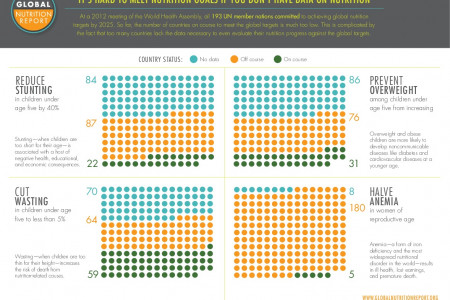
Economic Growth is a Double-Edged Sword for Nutrition
Economic Growth is a Economic growth helps reduce chronic DOUBLE-EDGED undernutrition in children under five. Economic growth has unintended effects on nutrition. SWORD for Nutrition A multicountry analysis shows that a 10% increase in gross domestic product (GDP) per person is associated with a 6% reduction in stunting in preschool children. A 10% increase in GDP is associated with a 7% increase in the prevalence of overweight and obesity in women. Economic Growth and Child Stunting* Economic Growth and Women's Overweight and Obesity* 80 Burundi Predicted overweight line Egypt Afghanistan Niger ETH Guatemala Jordan Bosnia-Herzegovina MDG Angola DRO Peru SDN PAK NGA Swaziland Bolivia O Serbia India Predicted stunting line Nicaragua MMR Turkey South Africa Guatemala VTN Lesotho Honduras KEN PHN South Africa Morocco Dominican Republic Peru Botswana Kyrgyzstan IDN IRQ Syria Egypt Haiti Moldova Brazil Ecuador Ghana Armenia Ghana Cameroon China Senegal Uzbekistan Sierra Leone Kenya Nigeria Thailand Algeria Kazakhstan Philippines Pakistan Thailand China Sri Lanka Turkey Moldova Colombia Indonesia Brazil Bangladesh India Belarus Ethiopia Vietnam 2000 4000 6000 8000 10000 2000 4000 6000 8000 10000 GDP per capita (2005 international $) GDP per capita (2005 PPP$) * The size of the circle represents the estimated population of stunted children aged 0-5 years, in 2005. Those countries below the line are doing well in reducing malnutrition. * The size of the circle represents the estimated population of overweight or obese women in 2005. Those countries below the line are To achieve real nutrition gains %3. doing well in reducing obesity. from economic growth, policymakers have to tackle nutrition on al| fronts and at all levels-from making social protection, agriculture, and other programs more nutrition-sensitive to providing an environment in which such programs can flourish. Notes: BGD=Bangladesh; DRC=Democratic Republic of the Congo; ETH=Ethiopia; IDN=Indonesia; IRQ=Iraq; MDG=Madagascar; MMR=Myanmar (Burma); KEN=Kenya; NGA=Nigeria; PAK=Pakistan; PHN=Philippines; SDN=Sudan; VTN=Vietnam. Text source: Ruel, M.T., H. Alderman, the Maternal and Child Study Nutrition Study Group. 2013. "Nutrition-sensitive interventions and programmes: How can they help to accelerate progress in improving maternal and child nutrition? The Lancet (Maternal and Child Nutrition 3). Published online June 6, 2013. http://dx.doi.org/10.1016/S0140-6736(13)60843-0. Data sources: Demographic Health Sur- veys. Measure DHS Stat-Compiler. http://www.statcompiler.com/. Accessed Nov 22, 2012. WHO. Global database on child growth and malnutrition. World Health Organization, 2012. http://www.who.int/nut- growthdb/database/en/. Accessed Dec 12, 2012. IFPRInfographic ifpri.org Copyright © 2013 International Food Policy Research Institute. IFPRI is a member of the CGIAR Consortium. Designed by J. Vivalo/IFPRI Stunting prevalence in preschoolers (%) 09 Female overweight prevalence, BMI>25 (%) 09
Economic Growth is a Double-Edged Sword for Nutrition
Publisher
IFPRISource
http://www.i...-nutritionCategory
EconomyGet a Quote











